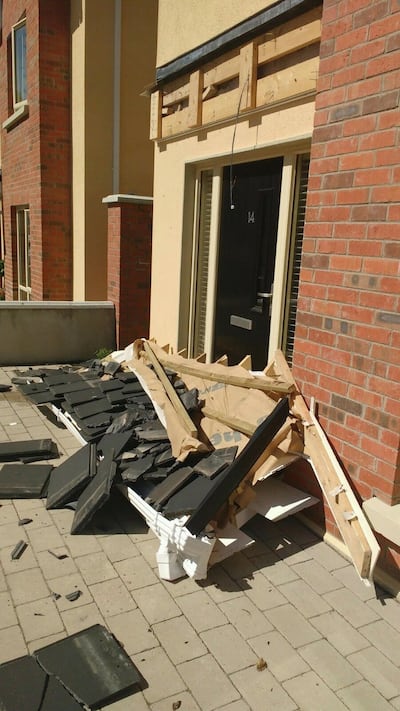Accountant John Gormley (now 38) gave his wife a kiss goodbye and waved her off to work on a Sunday morning in June 2018.
Minutes after closing the front door of their new home in Co Kildare, the house shuddered and he heard a wallop.
“I opened the door and the canopy was right at the door, it just dropped.”
An engineer’s report would later find the collapse of Gormley’s entire front door canopy, which had no supporting pillars and was tacked on to the house with just nails, could have been fatal.
RM Block
His story is not uncommon (read it in full here).
This week the Cabinet signed off on plans to repair between 62,500 and 100,000 defective properties built during the Celtic Tiger era, with an estimated cost to the exchequer of between €1.5 billion and €2.5 billion.
It is the accumulation of many years of campaigning by thousands of owners across the State who have lived with leaking windows, mouldy walls and paper-thin insulation.
Influx of homeowners
In December 2018, The Irish Times started an investigation which over the course of three years uncovered construction defects in 34 developments involving more than 2,500 apartments.
What started with a single news report on one development in Dublin 8 mushroomed into a very large project when an influx of homeowners contacted us with similar stories.
Some of them were facing bills of up to €60,000 to remediate severe mould, collapsing roof canopies, rotting balconies and an extensive lack of fire-safety measures.

One woman I spoke to had bought an apartment with her husband in a busy coastal village in the northwest of Ireland.
Built in 2008, it appeared attractive for its underfloor heating and premium location, but what the couple got was a home which they could not heat or air out, and which remained just two degrees above outdoor air temperature in the winter. Then the mould came.
It covered the walls, floors and bathrooms; a product of poor insulation and ventilation and a huge health risk for their son with cystic fibrosis.
In my reporting of this issue, I did not come across a single apartment complex which was able to secure an insurance claim to cover the cost of remediating fire safety defects
They ripped out floors and bathrooms, replaced windows and tried to insulate the apartment externally, all at a huge personal cost.
I often think of that woman and her son, how worried she and her husband must have been watching the green and black splodges creep up the walls, while not being able to afford to take doctors’ advice to leave the unhealthy environment.
Payment schedule
When it comes to remediating apartment defects, nothing is truly fixed until problems in entire blocks are eliminated. One apartment is not safe from a spreading fire unless the entire block is safe. Until common areas such as hallways, lift shafts and underground car parks are filled out with the correct fire-stopping material, no single unit in the building is safe – no matter how much an individual owner spends on trying to fix issues or introduce preventive measures.
This requires all owners to agree to a payment schedule outlined by the owners’ management company, and somehow find thousands of euro to pay for problems not of their own making.
But why can’t the builders be held responsible? Under Irish law, homeowners have just six years from the time a defect becomes “manifest” to try taking a builder or developer to court.
In most cases of missing fire-stopping or defective balconies, it is argued successfully that the damage became manifest on the day of building, putting Celtic Tiger builds outside the statute of limitations.
In my reporting of this issue, I did not come across a single apartment complex which was able to secure an insurance claim to cover the cost of remediating fire safety defects.
Many of the people I spoke to paid over the odds for their homes and were stuck in negative equity or unable to sell due to pending remediation works. In many cases their homes were uninhabitable and the bills to fund fixing them impossible to pay.

In one complex, the roof was disintegrating and was being held together by push/pull ties. In another, one owner had thrown out several wardrobes full of mouldy, damp clothes, as well as curtains, mattresses and couches, and had to repaint the entire place eight times.
Many of these homes were built when the construction industry here was at its capacity and the only real form of building regulation by the State was self-certification, where a fire-safety certificate was issued off plans and rarely followed up on after the build.
Unquantifiable liability
For years, successive governments refused to accept the State had any liability in remediating the issue for fear of exposing taxpayers to an unquantifiable liability.
But people were desperate for help. One woman I met in a complex in Dublin 13 asked: “Is it going to take an apartment block of burning bodies for the Government to do something about this?”
While campaigners remain anxious that a lot of work has yet to be done before the establishment of any State scheme, this week’s announcement is a positive step for the thousands of homeowners who just wanted a safe place to live.

















